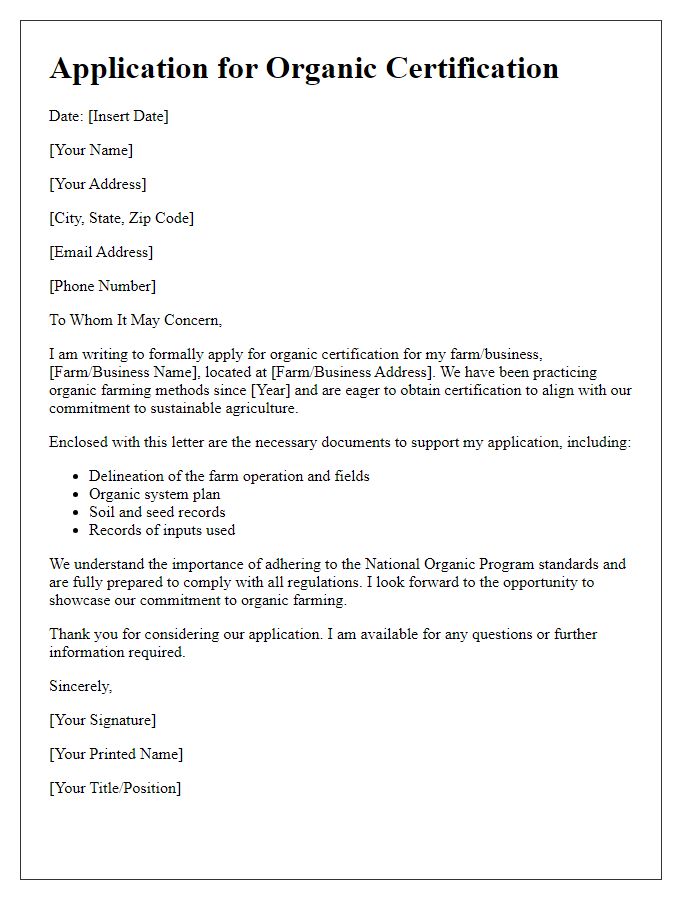Are you considering organic certification for your agricultural products? It can seem like a daunting task, but with the right guidance and resources, the process becomes manageable and rewarding. This article will break down each step in the organic certification process, ensuring you understand what to expect and how to navigate the requirements. So, let's dive in and discover how you can achieve that coveted organic labelâready to learn more?

Compliance with Organic Standards
Organic certification involves rigorous compliance with the United States Department of Agriculture (USDA) organic standards, including various regulations aimed at ensuring that agricultural products are produced and handled without the use of synthetic fertilizers, pesticides, and genetically modified organisms (GMOs). The National Organic Program (NOP) outlines specific guidelines that must be met, including soil quality management, biodiversity, and ecological balance to enhance environmental health. Records must be meticulously maintained, covering every aspect of the production process from soil inputs to final product sales to verify adherence to organic practices. Additionally, on-site inspections are conducted annually by accredited certifying agents to assess compliance with these comprehensive standards. The goal is to provide consumers with assurance that the food they purchase aligns with organic principles and contributes to sustainable agricultural practices.
Documentation and Record-Keeping
The organic certification process requires meticulous documentation and record-keeping practices to ensure compliance with standards set by organizations such as the USDA (United States Department of Agriculture). Farmers must maintain comprehensive records of all inputs, including seeds, fertilizers (preferably organic), and pest control methods used over the production cycle. Detailed logs of cultivation practices, equipment cleaning procedures, and crop rotations must be documented to demonstrate adherence to organic methods. Records of sales and distribution channels are also essential, ensuring traceability from farm to consumer. This documentation not only supports compliance audits but also fosters trust with consumers seeking certified organic products. Additionally, systems like farm management software can assist in maintaining organized records, showing both transparency and commitment to organic farming principles.
Organic System Plan (OSP)
The Organic System Plan (OSP) is a crucial document for farmers and producers seeking organic certification under USDA regulations. This plan outlines the agricultural practices, materials used, and overall management strategies that adhere to organic standards established in the Organic Foods Production Act. Key components include soil fertility management, pest control methods, and crop rotation practices, ensuring sustainable processes that promote ecological balance. Details of inputs like fertilizers and pesticides must comply with the USDA's National List of Allowed and Prohibited Substances. Additionally, record-keeping practices must be clearly defined to ensure traceability of organic products from farm to market. The OSP must be updated annually to reflect changes in farming practices and environmental conditions, demonstrating ongoing commitment to organic integrity. Each section of the plan should provide comprehensive information about the farming operation, methodologies employed, and efforts made toward enhancing soil health, biodiversity, and ecosystem services. This thorough documentation ultimately supports the transition to organic practices, ensuring compliance and facilitating a successful certification process.
Inspection and Verification Process
The organic certification process involves a comprehensive inspection and verification process designed to ensure compliance with established standards set by recognized authorities, such as the USDA National Organic Program in the United States. This process typically begins with a detailed application submission by farmers or processors seeking certification, outlining their practices and inputs used in operations. An on-site inspection is conducted by an accredited certifying agent, focusing on various aspects such as soil quality, pest management strategies, and organic input usage, ensuring adherence to organic principles. During the inspection, critical records are reviewed, including input receipts and crop production logs, to verify organic practices and traceability. Post-inspection, a report is generated summarizing findings, detailing any non-compliance issues, and outlining necessary corrective actions. Certification is granted once all criteria are satisfactorily met, leading to the issuance of an organic certificate, which remains valid for up to three years, provided annual inspections continue to confirm compliance.
Continuous Improvement and Updates
The organic certification process requires ongoing dedication and adjustments to adhere to evolving standards set by organizations like the USDA (United States Department of Agriculture) or the EU (European Union) organic regulations. Continuous improvement involves regular training sessions for staff to stay informed about the latest practices, ensuring compliance with the National Organic Program (NOP) standards. Documentation must be meticulously updated, covering aspects like farming methods, pest management strategies, and soil health monitoring protocols. Regular audits, both internal and external, play a critical role in identifying areas for enhancement. Furthermore, incorporating feedback from certification bodies can lead to better resource management and minimize environmental impact. Engaging with local agricultural extension offices may provide valuable insights into innovative organic practices tailored to specific regions, like the Midwest's corn-soy rotation systems. Regular updates to the organic management plan keep all stakeholders informed and aligned with sustainable goals.













Comments